
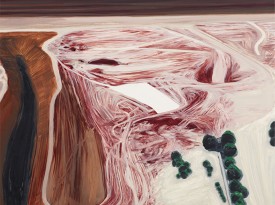
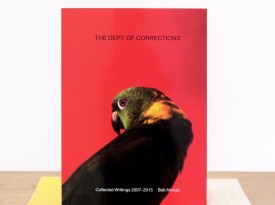
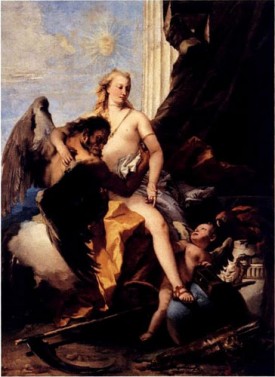
Tiepolo Pink by Roberto Calasso
Giambattista Tiepolo (1696 – 1770), very famous and much in demand in his lifetime, has a roomful of his enormously tall paintings at the entrance to the European galleries of the Metropolitan Museum. Thought to be just a gifted decorative artist, unlike Piero della Francesca, he has not has not become a culture hero. In a … Continued

Towards an Immersive Intelligence: Essays on the Work of Art in the Age of Computer Technology and Virtual Reality 1993-2006 by Joseph Nechvatal
Joseph Nechvatal was ahead of the curve. In 1986 he was using computers and computer robotics to make paintings and from 1991-1993 he experimented with computer viruses. Nechvatal co-founded Tellus Audio Cassette Magazine in 1983, and makes audio art to this very day, using computer viruses to influence the compositional process. Nechvatal firmly believes that … Continued

Ann Stokes: Artists’ Potter, edited by Tanya Harrod
Some artists change the way that you understand art history. Ann changed the way that I and many other people understood everyday life.
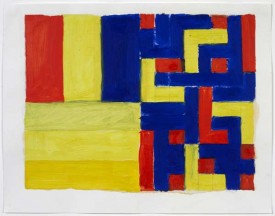
Books in Brief
NAMIES AND NEWBIES: THE KRAMARSKY COLLECTION 560 Broadway A New York Drawing Collection at Work 1991-2006, edited by Amy Eshoo, with contributions by Derrick R.Cartwright, James Cuno, Elizabeth Finch, Josef Helfenstein, Glenn D. Lowry, David Mickenberg, Ann Philbin, Earl A. Powell III, Jock Reynolds, and Townsend Wolfe. Fifth Floor Foundation in Association with Yale University Press, … Continued
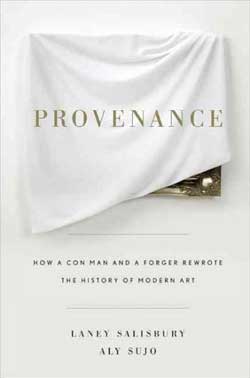
Provenance: How a Con Man and a Forger Rewrote the History of Modern Art by Laney Salisbury & Aly Sujo
One of art historian Leo Steinberg’s hobby horses is the way the literature of art generates interpretations that are autonomous of the images being described. What is written about a work can spin false leads and confused trails that looking directly at the work ought to dispel. Just as this happens with the historical interpretation of … Continued

Nine Lives: The Birth of Avant-Garde Art in New China by Karen Smith; and Ai WeiWei by Karen Smith, Hans Ulrich Obrisi, Bernard Fibicher
It may seem odd to locate the birth of the Chinese avant-garde so close to the present, for in the West that period style label is associated with the late 19th Century, but in the early 1980s, China was emerging from a long period of being effectively cut off from the outside world.

Abstract Expressionism and the American Experience: a Reevaluation by Irving Sandler
Is there anyone in our Manhattan art world who does not know Irving Sandler? Much loved, he is our Vasari, the tireless chronicler who attends every lecture, goes to every show, and knows every artist and critic. In this well illustrated book, a revision of his classic The Triumph of American Painting, he focuses on 1942 … Continued
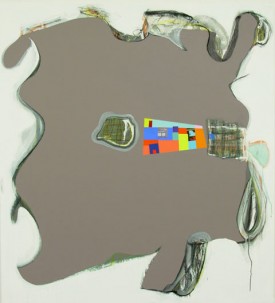
The Art Critic by Peter Plagens
I’ve long felt that Peter Plagens and I had a community of interest, as we’ve both written about art for weekly newsmagazines (he for Newsweek, I for Time, having preceded Robert Hughes in that slot). Imagine my delight when I learned last August that Plagens was publishing his second novel, The Art Critic, in 24 installments on artnet! Twenty-four … Continued

Proust/Warhol by David Carrier
Marcel Proust begins his novel In Search of Lost Time with a famously long passage in which the Narrator describes sleep, or more properly, the antics of his imagination, while semi-conscious. When I read this passage for the first time, the image that most struck me was that of the Narrator sitting in an armchair reading … Continued

Jean Prouvé by Laurence Bergerot and Patrick Seguin (editors)
Chelsea, New York gallery goers with an astute eye for furnishings will have picked up on the cult status of French mid-century modernist Jean Prouvé. A vintage specimen of his legendary Potence lamp provides scant illumination and surreally displaced period charm to the very public back office at Sonnabend Gallery, for instance; a weatherworn school … Continued

